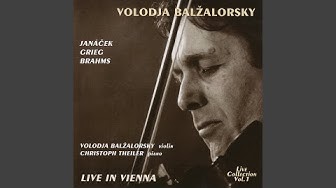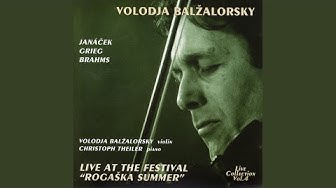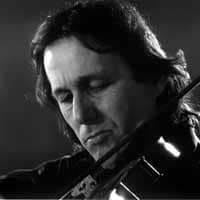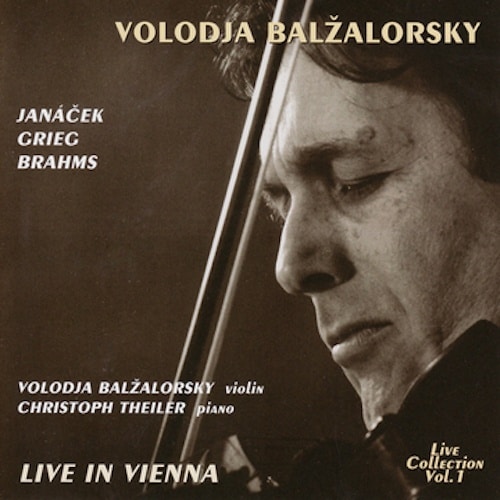Fanfare Reviews-Live collection of Volodja Balzalorsky Vol1-4
(Tuesday, June 01, 2010) – CD Review by Robert Maxham
JANACEK Violin Sonata. GRIEG Violin Sonata No. 3. BRAHMS Violin Sonata No. 3 •
Volodja Balzalorsky (vn); Christoph Theiler (pn) ‚CANTABEL 001 (64:17) Live: Vienna 3/7/1996
Volodja Balzalorsky (vn); Christoph Theiler (pn) ‚CANTABEL 004 (62: 07) Live: Rogaska 9/1995

Two of the releases in Cantabel, Live Collection series present the duo of Slovenian violinist Volodja Balzalorsky and German pianist Christoph Theiler in identical programs, one in Vienna on March 7, 1996, and the other in Rogaska in September 1995.
In Janacek’s sonata, the Vienna performances of the first two movements each ran 10 seconds longer than those at Rogaska.
Similarly, the first and last movements of Grieg’s sonata both took about 44 seconds longer in Vienna than did the corresponding performances in Rogaska, while the timings for the other movements and the entire Brahms sonata differed by only a few seconds, respectively. Yet the generally slower tempos in Vienna seem consistent enough to deserve notice.
In Vienna, the first movement of Janacek’s sonata sounded more kittenish than ominous, though Balzalorsky’s tone possesses the fibrous strength (and, where necessary, the richness) to express ideas of any voltage.
The recorded sound (from the Bösendorfer Hall) seems a bit cavernous. I didn’t touch my dial, as TV announcers have continually warned me not to, between performances, but neither the closer miking at Rogaska nor the 10 seconds of difference between the timings could entirely explain the greater urgency of the earlier performance.
In Vienna, the second movement sounded richly lyrical; in Rogaska, perhaps because of the closeness of the miking, Balzalorsky programatically, it should, in both venues. The fourth offers the violinist opportunities for mixing the vaulting with the haunting, and Balzalorsky, the disturbing interruptions may seem to some listeners to make the deeper impression, and the conclusion seems more troubling emotionally.
In Vienna, Balzalorsky and Theiler played with drive and ardor in the first movement of Grieg’s C-Minor Sonata, imparting special piquancy to the off-beat accompanying figures (even in Kreisler’s celebrated performance with Rachmaninoff, they don’t tease the violin part so impudently), and Theiler introduces the coda with a tantalizing sense of expectancy; the performance in Rogaska opens even more stormily (remember, it’s 44 seconds shorter). In fact, it’s an electrical storm, with enough voltage to knock Ben Franklin’s kite out of the air, if not electrocute its flier.
But if the accompanying patterns mentioned above sound more perfunctory, the faster tempo may be responsible; the performance, for all its closeness to the microphones, nevertheless seems highly nuanced. Theiler played the simple opening of the second movement with heartfelt poetic sensitivity, which Balzalorsky’s more straightforward reading of the theme seemed to match principally in tempo; if he didn’t equal Kreisler and Rachmaninoff’s rhythmic verve in the central section, he achieved his own sort of élan.
Fanfare Reviews-Live collection of Volodja Balzalorsky Vol1-4
Theiler sounded equally sensitive in Rogaska a noticeably faster tempo in the opening measures; Balzalorsky drew, in this venue, upon the full resources of his instrument to create a glowing account of the violin part, drawing up to equal partnership with Theiler throughout the movement.
The third movement sounded dramatic in Vienna, despite a somewhat slow tempo, and Balzalorsky played the yearning second theme with a sweet tone that darkened on the G string, never growing hoarse, even as the passages climbed into the string’s throatiest registers and he punctuated it with thrilling, sharp accents.

If this reading of the movement seemed to lack forward drive, the duo compensated for it in their blazing account of the last pages. Although the applause sounds tepid, it’s hard to understand why.
The performance in Rogaska took a similar approach, although the first time I heard it, Balzalorsky seemed strained, but that impression faded even upon a second hearing.
And he played the sighing gestures in the secondary theme with a genuine sob. Perhaps inspired by Balzalorsky, Theiler executed a transition of exceptional sensitivity from the singing passage back to the leaping initial one.
Still, the duo didn’t take off with lightning rapidity in the coda in this reading. Both performances sound as though they might have been taped in performances by Norway’s fiddling (Hardanger fiddle?) troll, Fossegrimmen.
However deeply felt their reading of Grieg’s sonata, Balzalorsky and Theiler possibly communicated with each other most effectively in Brahms’s D-Minor Sonata.
Their reading of the first movement in both venues conveyed the work’s somber glow (although the one in Rogaska seems at the same time, paradoxically, slightly more subtle and slightly more magisterial), enhanced by Balzalorsky’s buttery tone, which, however, lacked nothing in tensile strength when Brahms’s angular passagework requires it.
The duo gave a deeply moving account of the slow movement in both venues, too, although with the expressivity, perhaps, less forced and more directly appealing in Vienna. The noticeably quicker pace of the third movement in Rogaska’s more relaxed elegance. Yet the more headlong performance of the finale in Rogaska didn’t steamroll a wealth of detail richer than that in the Vienna performance.
Fanfare Reviews-Live collection of Volodja Balzalorsky Vol1-4
Since both CDs share the same photograph and, except for the title on the cover, the same booklet’s well, of course, as the same program listening to them elicits a question similar to the one TV announcers posed about twins and a home-permanent product several decades ago: Which twin … ? In this case, since the recorded sound seems so much edgier in the Rogaska recital, it’s tempting to give the nod to the Vienna disc, but to acquire only that one would be to miss much of depth and beauty. Both recommended.
Robert Maxham
This article originally appeared in Issue 33:5 (May/June 2010) of Fanfare Magazine.
Fanfare Reviews-Live collection of Volodja Balzalorsky Vol1-4
About Volodja Balzalorsky

Volodja Balzalorsky from Ljubljana, Slovenia, performs internationally as a soloist, recitalist, and chamber musician.
Numerous highly praised concerts, broadcasts, CD, and TV recordings in various countries have established his reputation as an artist with a sensitive, intelligent, and intuitive gift of interpretation, a polished technique, and a rich, full tone.
Volodja is particularly active in the field of chamber music. He works with many international groups and ensembles. He has built long-term partnerships with several musicians, including pianists Christoph Theiler, Hinko Haas, Aleksandar Serdar, and Peter Caelen, percussionist Amy Lynne Barber, and his fellow members of the Amael Trio, pianist Tatjana Ognjanovic, later pianist Zoltan Peter and cellist Damir Hamidullin.
For his artistic achievements, he was awarded several international music awards:
He is Two Time Winner and Four-Time Nominee of Independent Music Awards.
Volodja is also the recipient of several further international music awards such as The Hollywood Music in Media Award, The Inland Empire Music Award, The Ontario Independent Music Award, The Canary Island Music Award, and Julij Betetto Music Award.

